

|
|
|
"Knowledge is power. Information is liberating. Education is the premise of progress, in every society, in every family." - Kofi Annan
|
|
|
5 October 2018
|
TCO Gazette Links
Click here for TCO archive Click here for news archive |
News Headlines Aussie Reptiles Saved from Illegal Export
In the last three months alone, Australian Border Force (ABF) officers have stopped a total of 20 separate consignments containing more than 110 reptiles from being illegally exported overseas.
Back in July, eight consignments were intercepted in boxes labelled as toys, kids and baby clothing and shoes, school bags and bags of chips. Another eight detections were made in August containing approximately 40 reptiles, and in September there were four detections containing 38 reptiles. The international mail parcels were mainly posted from Melbourne or Sydney and were destined for China, Hong Kong, Indonesia or Russia. The native species included shingleback lizards, eastern spiny tailed skinks, geckos, blue tongue lizards and gidgee skins. Some reptiles were found stuffed in socks within cereal and chip boxes, whilst others had their legs taped together. ABF Acting Assistant Commissioner Craig Palmer said these detections should demonstrate to potential wildlife smugglers that Australian authorities are on to these illicit activities. “Wildlife smuggling is a lucrative trade and we know individuals and criminal syndicates can make significant profits by exporting and selling Australia’s unique native fauna overseas, particularly in Asia,” Palmer said. “The ABF is committed to protecting Australian wildlife and works closely with state and federal agencies to detect, disrupt and investigate those involved in this cruel trade. We are working with our colleagues at Australia Post, industry, consumer groups, as well as federal and state environment agencies, to increase our ability to identify who is involved and where they are sending these animals. If successfully exported, these animals are fed into illicit markets that are of significant interest to law enforcement overseas, particularly in Asia. Working with our partners throughout the region is a key part of our strategy in combatting this issue.” Maersk Trials Polar Route UPDATE
Back in August we wrote about Maersk trialling a polar route to explore the feasibility of container shipping through the Northern Sea passage. And late last week, as scheduled, the Venta Maersk arrived in Saint Petersburg, Russia. After a month long journey, Maersk chief technical officer Palle Laursen said the trial passage allowed the company to gain operational experience, test vessel systems, crew capabilities and the functionality of the shore-based support setup.
According to a statement from Maersk, the voyage went to plan and the vessel and systems aboard performed well in the harsh environment. While the passage is usually feasible this time of year, ice conditions in the East Siberian Sea did require the assistance of icebreakers. “We are very happy to welcome back crew and vessel safe and sound after this unique voyage,” Mr Laursen said. “Currently, we do not see the Northern Sea Route as a viable commercial alternative to existing east-west routes,” he advised. “In general, we plan new services according to trading patterns, population centres and our customers’ demand.” Maersk emphasised that this voyage was a one-off trial designed to gain operational experience in a new area and to test vessel systems. However, Mr Laursen said the company is following the development of the Northern Sea Route. “Today, the passage is only feasible for around three months a year which may change with time,” he said. “Furthermore, we also must consider that ice-classed vessels are required to make the passage, which means an additional investment.” New Quay Cranes for DP World
This week a shipment of five quay cranes for DP World Australia terminals arrived at Fremantle on the ship Zhen Hua 24. The ship plans to unload one of the cranes at Fremantle before departing for Brisbane to unload one crane, then to Sydney to unload two cranes, and then to Melbourne to unload the final crane. The shipment is the final delivery of DP World Australia's nine-crane order from ZPMC, as part of $180m investment in equipment to enable the service of large vessels and to work more efficiently.
The Future is Smart Ships
Victorian Ports Corporation chief executive Rachel Johnson said ports need to prepare for a future of smart and even fully-automated ships.
Speaking at the Supply Chain Logistics Digitial Transformation and Disruptive Innovation Forum, she advised that container ships were becoming larger and ports were becoming more complex. And as crew numbers decrease due to innovative technology, space onboard ships should increase with the removal of crew amenities. In turn, the vessel would become lighter and with the reduced energy costs, the capacity for containers onboard would become greater. So ultimately, automation is a very desirable way for ships to go. Ms Johnson referred to research suggesting the first remote operation of an “unmanned coastal vessel by 2025” and fully autonomous ocean going vessels by 2035. “So quite an interesting and challenging timeline,” she said. Ms Johnson also spoke about logistics in and around the Port of Melbourne, including the need for rail. “Melbourne (the city) is growing faster than any other capital city and that means we will be seeing larger ships coming in and more containers. In terms of the evolution of the supply chain, it is not just about the types of vessels, it is about automation at the port and it is also about being able to rail up and going,” she said. “Anybody who thinks you should move 3m containers through built up metropolitan areas, which is actually what is around the port, and you do that on road, it just beggars belief.” Maersk Liner Service to Australia
The Leda Maersk containership marked the celebration of Maersk's "25th anniversary of operating a dedicated liner service to Australia" in Sydney Harbour this week.
Managing Director of Maersk Line Oceania Gerald Morrison said on behalf of the company he was honoured to have played a part in the growth of the industry. According to Maersk, in the past 25 years alone more than 3.5 million of their ships have made the journey to and from Australia. Their ships have helped distribute our prime Australian beef, wine, dairy, fruit and grain to the rest of the world. And over the years, they have carried many household and industrial products to our shores for Australian consumers and manufacturers. “Australia’s international trade has quadrupled over the last two decades, and to keep up with the increasing demand for global shipping services, Maersk Line’s Australian product offering has also grown exponentially,” Mr Morrison said. “In 1993, our inaugural service provided a 10-day shuttle frequency to Japan and Korea with two 1100-TEU size vessels. Today, our largest vessels calling Australia have been upsized to 7000 TEU and we now operate a total of ten services, making more than 1000 port calls a year around the Australian coast.” DP World Infrastructure Access Charge
From 1 January 2019, DP World Australia will be increasing the Infrastructure Access Charge at their Port Botany Terminal for road and rail operators, and will also be adjusting a number of ancillary charges.
The infrastructure access charge will be $63.80 per container (exclusive of GST) and will apply to all full containers received or delivered via road or rail at Port Botany Terminal. In addition, a number of adjustments to Container Terminal Ancillary Charges will also apply at Port Botany Terminal from 1 January 2019. These include: Friday Funnies
A few riddles to ease you into the weekend!
Q. A man is washing windows on the 25th floor of an apartment building. Suddenly, he slips and falls. He has nothing to cushion his fall, and no safety equipment—but he doesn't get hurt. How is this possible? Q. What do scientists use to freshen their breath? Q. I have hundreds of wheels, but move, I do not. Call me what I am: Call me a lot. What am I? Q. I weigh nothing, but you can still see me. If you put me in a bucket, I make the bucket lighter. What am I? |
       |